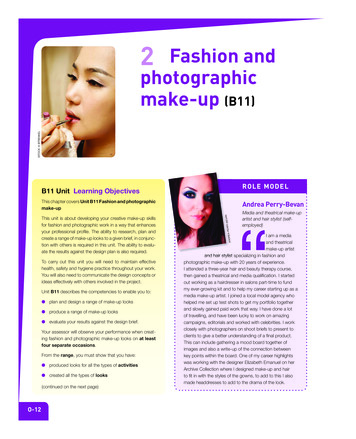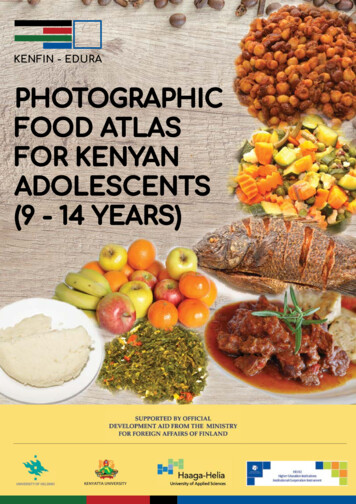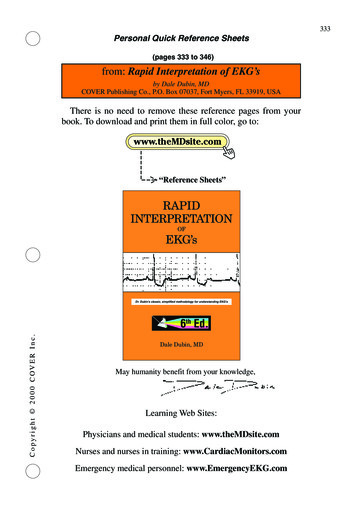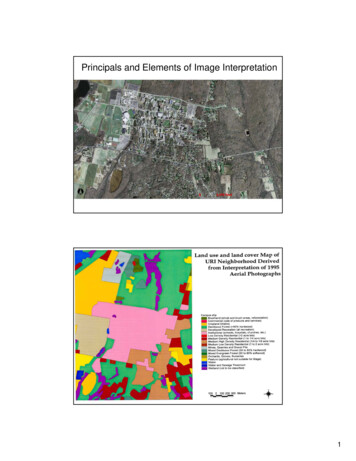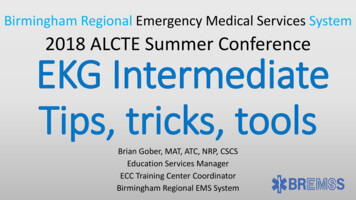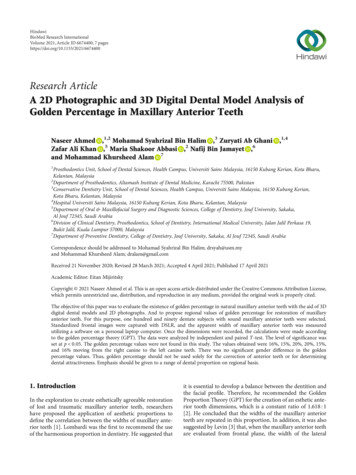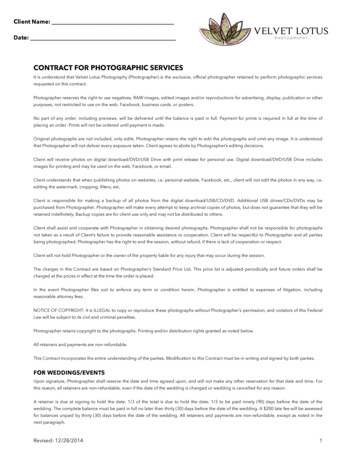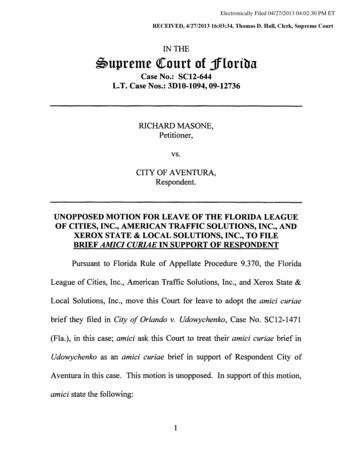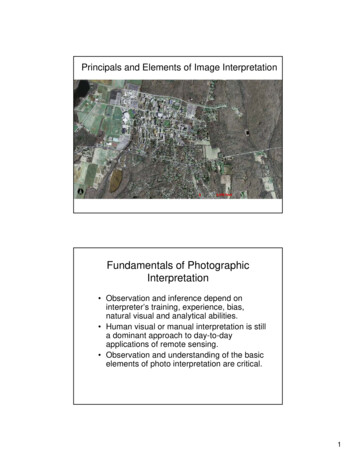
Transcription
Principals and Elements of Image InterpretationFundamentals of PhotographicInterpretation Observation and inference depend oninterpreter’s training, experience, bias,natural visual and analytical abilities. Human visual or manual interpretation is stilla dominant approach to day-to-dayapplications of remote sensing. Observation and understanding of the basicelements of photo interpretation are critical.1
Why photo/image interpretation? Aerial/Regional Perspective:– Examination of the Earth from an aerialperspective allows us to identify objects,patterns, and man-land interrelationships.– Remotely sensed image provides “spatialterrain” information.Why photo/image interpretation? The ability to obtain a historical image record todocument change:– The photographs or images are valuable historicalrecords of the spatial distribution of natural and manmade phenomena.– The study of change increases our understandingabout the natural and human-induced processes inthe landscape.2
Why photo/image interpretation? Three-Dimensional Depth Perception:– We can obtain a 3-dimensional view of the terrain byviewing the two images of the terrain from two slightlydifferent vantage points at the same time.– Stereoscopic analysis process provides us theinformation of object’s height, depth, and volume.Deriving Information from DataHeads-up digitizing- Visual interpretation and manualdelineationDigital image classifications– Unsupervised– Supervised3
Digital Image Classification?4
Information Extraction from PixelsPrincipals and Elements ofVisual Image Interpretation5
Fundamentals of PhotographicInterpretationPhoto Interpretation:The examination of aerialphotographs/images for thepurpose of identifying objectsand judging their significance.Observation & Inference:Observation provides the rawdata for interpretation.Inference is the logical processby which observation andinterpretation are made.Elements of Image Interpretation x,y LocationSizeShapeShadowTone/ColorTexture Pattern Height/Depth Site (elevation, slope,aspect) Situation Association6
Elements of Image InterpretationElementx,y locationSizeShapeCommon Adjectives(Quantitative and qualitative)x,y coordinate: longitude and latitude or meterseasting and northing in a UTM map gridLength, width, perimeter, area (m2)small, medium (intermediate), largeAn object’s geometric characteristics: linear,curvilinear, circular, elliptical, radial, square,rectangular, triangular, hexagonal, pentagonal,star, amorphous, etc.The size of an object is one of the most distinguishingcharacteristics and one of the most important elementsof image interpretation.Many natural and man-made features on the groundhave very unique shapes that can be referenced inphoto and image interpretation.7
Elements of Image nCommon Adjectives(Quantitative and qualitative)Caused by solar illumination from the sideGray tone: light (bright), intermediate (gray),dark (black)Color: HIS intensity, hue (color), saturation;RGB red, green, blueCharacteristic placement of objects on theground: systematic, random, linear, curvilinear,rectangular, circular, etc.Spatial arrangement of objects on the ground:systematic, random, linear, curvilinear,rectangular, circular, etc.The shadow in the image provides real clue to anobject’s identification, e.g., height.The ability to visually appreciate or measure theheight (elevation) or depth (bathymetry) of an objector landform is one of the most diagnostic elements ofimage interpretation.8
The electromagnetic radiation (EMR) recorded byremote sensing system can be displayed in shades ofgray ranging from black to white – tone.We may use additive color-combining techniques tocreate color composite images.Gray TonePseudo Color ImageTexture is the characteristic placement and arrangementof repetitions of tones or color in an image.Pattern is the spatial arrangement of objects in thelandscape.Both texture and pattern are scale independent.TexturePattern9
Elements of Image ctSite/situation/associationCommon Adjectives(Quantitative and qualitative)z-elevation (height), depth (bathymetry),volume (m3), slope o, aspect oSite: elevation, slope, aspect, exposure,adjacency to water, transportation, utilitiesSituation: objects are placed in a particularorder or orientation relative to one anotherAssociation: related phenomena are usuallypresentSite, situation, and association characteristics arevery important when trying to identify an object oractivity. They are always used together.Site:- physical (elevation, slope,aspect, type of surface cover)- socioeconomic (value of theland, adjacency to water)Situation:How objects are organized andoriented relative to one another.Association:When you find a certain activityor phenomena, you almostinvariably encounter related orassociated features or activities.10
Where to draw the line?The Photo-OverlayLeft: aerial photographRight: land cover boundaries as interpreted fromthe photographs; numbers corresponded toAnderson Level II classification system.11
The delineation of a land use polygon includes the entirearea devoted to a particular use. In this example the entirearea inside the boundaries of an airfield is represented onthe land use map as a single polygon, even though it iscomposed of several recognizable components.12
13
Land-Use MapLand-Cover Map The use of land by humans,usually with emphasis onthe functional role of land ineconomic activities Land use forms anabstraction, not alwaysdirectly observable even bya closest inspection Designates the visibleevidence of land usefeatures. Directly observablephysical or biophysicalcover on the earth’ssurface CONCRETE ABSTRACTThe definition establishes a direct link between landcover and the actions of people in their environment.An Example of Land-Use Map vs. Land Cover Map (e.g., Extracted Impervious Surface dWaterWetlandOpenlandUrban Grass14
QuonsetStateAirportNarragansett BayAn Example of Land-Use Map vs. Land Cover Map (e.g., Extracted Impervious Surface plandBrushlandWetlandUrban GrassUse of color as symbols for land useclasses by USGS system Level ICategoryUrban/Built-up LandAgricultural LandRangelandForest LandWaterWetlandBarren LandTundraPerennial Snow or IceSymbol123456789ColorRedLight BrownLight OrangeGreenDark BlueLight BlueGrayGreen-GrayWhite15
Vertical aerial photographor satellite imageryMeasurable thematicinformation16
gray ranging from black to white –tone. We may use additive color-combining techniques to create color composite images. Texture Pattern Texture is the characteristic placement and arrangement of repetitions of tones or color in an image. Pattern is the spatial arrangement of objects
